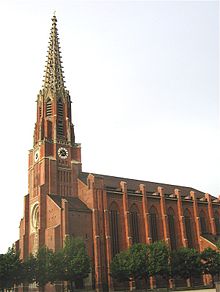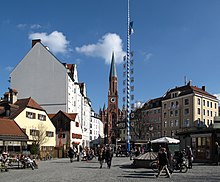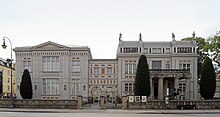Au-Haidhausen
|
Au-Haidhausen
State capital Munich
Coordinates: 48 ° 7 ′ 55 ″ N , 11 ° 35 ′ 20 ″ E
|
|
|---|---|
| Area : | 4.22 km² |
| Residents : | 61,654 (Dec. 31, 2019) |
| Population density : | 14,611 inhabitants / km² |
| Postcodes : | 81541, 81543, 81667, 81669, 81671, 81675, 81677 |
| Area code : | 089 |
|
Location of the city district 5 Au-Haidhausen in Munich
|
|

Au-Haidhausen is the city district 5 of the Bavarian capital Munich .
The city district consists of the districts of Au and Haidhausen .
location
The Au lies opposite the old town on the eastern lowland of the Isar , to a lesser extent on the Isar high bank, Haidhausen above the lower Au all on the Isarhchterrasse. District 5 borders on Bogenhausen in the north, on Altstadt-Lehel and Ludwigsvorstadt-Isarvorstadt in the west, on Berg am Laim in the east, Obergiesing in the south , and Untergiesing on the Isar river level .
The boundary of the city district is formed in the north by Prinzregentenstrasse , in the east by the east side of the railway line, in the south by Humboldtstrasse and in the west by the right bank of the Isar . The border between Au and Haidhausen is formed by the Rosenheimer- , Hoch-, Rabl- and Balanstraße, the further course of the Hochstraße on the Isar high bank and its eastern cross streets to the border with Obergiesing forms the Obere Au in contrast to the Untere Au.
Neighboring districts are Bogenhausen in the north, Berg am Laim in the east, Ramersdorf-Perlach in the southeast, Obergiesing-Fasangarten and Untergiesing-Harlaching in the south and Ludwigsvorstadt-Isarvorstadt and Altstadt-Lehel in the west.
History and description
The Au and Haidhausen used to be the hostel quarters for craftsmen and day laborers at the gates of Munich. Both formerly independent communities (the Au are equipped since 1808 with city rights) on October 1, 1854 incorporated been and have been in the early days developed into working class suburbs. An unusually large number of breweries used to have their headquarters here, as they found good locations for deep wells and storage cellars on the right bank of the Isar, i.e. on the edge of the terrace; hence the name "cellar" for the large brewery restaurants. Before the war, the Bürgerbräukeller , the site of the first attack on Adolf Hitler , stood near Rosenheimer Platz on Rosenheimer Strasse . After the State Hofbräu moved from Haidhausen to Riem in 1988, only one of Munich's large breweries, Paulaner , was in the Au until 2013 . In Haidhausen, the last relics of the great breweries are the Hofbräukeller and the Unionsbräu , both of which are only parts of formerly large breweries, today used as restaurants, among other things.
The structure of the Au was in the Second World War by an air raid on 24./25. Badly damaged in April 1944 and restored in the fifties with quickly built simple apartments for low-income households, so that today only about a fifth of the stock is from before 1919. In Haidhausen, the historical cityscape remained largely intact. The French quarter from the Wilhelminian era , so named because of the street names assigned there after locations of victorious battles in the Franco-Prussian War, is of particular importance for urban development . The well-preserved stock of houses meant that Haidhausen became the city's second major redevelopment area alongside Schwanthalerhöhe in the 1970s . The upgrading of the quarter triggered by the redevelopment was not only accompanied by a structural change from a suburb to the outskirts of the city, but also a change in image. As a result, Haidhausen began to compete with Schwabing as a trendy district .
The previously even mix of residential and commercial use in the Au and Haidhausen has shifted towards the residential area due to the outsourcing of disruptive business and usage changes. Most jobs in the district are now in the service and public sectors.
Haidhausen is home to the Bavarian State Parliament in the Maximilianeum , the Klinikum rechts der Isar and the Wiener Markt .
As a transition to the city center, the Gasteig (a district name of gacher (= steep) Steige that occurs more often in Bavaria ) has a special meaning. The cultural center on Gasteig was built here in the 1980s, bringing together the headquarters of the city library , the Munich adult education center , the conservatory and the philharmonic orchestra under one roof.
Immediately adjacent is another cultural area, the Muffatwerk ; the Art Nouveau building used to be a power station. Gasteig and Muffatwerk play a central role in Munich's cultural and musical life. Next to the Muffatwerk directly on the Isar is the imposing Art Nouveau building of the Müller Volksbad . Further north in the Maximilian Park is located on the (guided underground here) Auer mill just before its confluence with the Isar, the Maximilian work . This hydroelectric power station , also known as the Maxwerk , is after the Muffatwerk the oldest power station on Munich soil and is still in operation today.
In the Au, with the folk fair that takes place three times a year, the Auer Dult on Mariahilfplatz and the strong beer tapping on the Nockherberg have preserved more traditional everyday culture than in other Munich districts.
The Neudeck women's and youth detention center was located between Mariahilfplatz and Nockherberg, separated there by the Auer Mühlbach . The neo-baroque building from the beginning of the 20th century offered space for 124 prisoners. The prison is currently empty and an investor is planning to build high-priced condominiums there.
In the Au district, at the beginning of the Hochstraße, is the Sudeten German House , which is the seat of various Sudeten German institutions.
The social structure of the two districts has rejuvenated in recent years. Haidhausen already underwent gentrification in the 1980s . Since the beginning of the 21st century, the Au has been moving in areas where there are no subsidized apartments from the municipal housing association GWG or housing cooperatives [e.g. B. Bauverein Haidhausen eG], with expensive rental and owner-occupied apartments.
Personalities
The Munich comedian, folk singer, author and film producer Karl Valentin grew up in the Au.
statistics

(As of December 31, residents with main residence)
| year | Residents | including foreigners | Inhabitants per km² |
|---|---|---|---|
| 2000 | 52,028 | 13,257 (25.5%) | 12,336 |
| 2001 | 51,947 | 12,954 (24.9%) | 12,317 |
| 2002 | 52,000 | 13,007 (25.0%) | 12,330 |
| 2003 | 51,636 | 12,759 (24.7%) | 12,243 |
| 2004 | 51,383 | 12,307 (24.0%) | 12,182 |
| 2005 | 52.502 | 12,322 (23.5%) | 12,447 |
| 2006 | 54,382 | 12,367 (22.7%) | 12,892 |
| 2007 | 55,288 | 12,247 (22.2%) | 13,107 |
| 2008 | 55,853 | 12,247 (21.9%) | 13,237 |
| 2009 | 55,590 | 11,765 (21.2%) | 13,174 |
| 2010 | 56,322 | 11,968 (21.2%) | 13,348 |
| 2011 | 57,297 | 12,423 (21.7%) | 13,579 |
| 2012 | 58,881 | 13,049 (22.2%) | 13,954 |
| 2013 | 59,752 | 13,629 (22.8%) | 14,161 |
| 2014 | 60,756 | 14,225 (23.4%) | 14,399 |
| 2015 | 61,495 | 14,814 (24.1%) | 14,574 |
| 2016 | 61,699 | 15,327 (24.7%) | 14,693 |
| 2017 | 60,937 | 14,189 (23.3%) | 14,441 |
| 2018 | 61,356 | 14,446 (23.5%) | 14,541 |
| 2019 | 61,654 | 14,519 (23.5%) | 14,611 |
Source with further data
politics
The Au-Haidhausen district committee was last elected on March 15, 2020. The distribution of seats is as follows: Greens 13, SPD 5, CSU 5, LINKE 2, FW / ÖDP 1 and FDP 1. Of the 46,360 residents in Au-Haidhausen who are entitled to vote, 25,309 have exercised their right to vote, bringing the turnout to 54.6 % (2014: 44.4%).
literature
- Helmuth Stahleder : From Allach to Zamilapark. Names and basic historical data on the history of Munich and its incorporated suburbs. Edited by the Munich City Archives, Buchendorfer Verlag, Munich 2001, ISBN 3-934036-46-5 .
- Hermann Wilhelm: Haidhausen Münchner Vorstadt in the course of time. From the rural settlement to the district of Munich. Buchendorfer Verlag, Munich 1991, ISBN 3-927984-09-4 .
Web links
- District Au - state capital Munich
- District Haidhausen - state capital Munich
- City district and district committee 5 Au-Haidhausen - City of Munich
Individual evidence
- ↑ Statistical Pocket Book 2020 (PDF). Statistical Office of the State Capital Munich. Retrieved August 24, 2020.
- ↑ http://www.abendzeitung-muenchen.de/inhalt.brauerei-nach-377-jahren:-paulaner-verlaesst-die-au.8001dd0e-8d92-4d14-b98a-6ed23908f5f4.html
- ↑ Archived copy ( memento of the original from September 10, 2011 in the Internet Archive ) Info: The archive link was inserted automatically and has not yet been checked. Please check the original and archive link according to the instructions and then remove this notice.
- ↑ http://www.abendzeitung-muenchen.de/inhalt.paulaner-gelaende-die-au-nach-paulaner:-gruen-wohnen-luxus-kritik.a27f5597-04cc-4b74-a643-d37b7003e0cc.html
- ^ Archive district information . State capital Munich. Retrieved January 6, 2019.
- ↑ a b c Election of the District Committee - District 5 - Au-Haidhausen . State capital Munich. Retrieved March 20, 2020.






